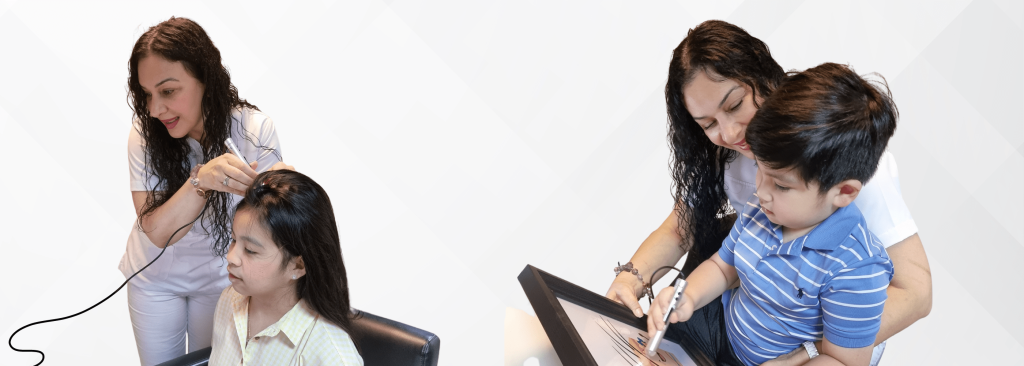
Hair Loss Treatments
for Children
SPECIALIZED HAIR LOSS TREATMENT FOR CHILDREN:
Restoring Confidence and Hair Health
Hair Loss Treatment
At Vivandi Trichology Center, we understand that hair loss can be especially distressing for children and their families. We are dedicated to providing compassionate and effective hair loss treatment services tailored specifically for children. Our team of experienced professionals is committed to helping children regain their natural hair, restore their confidence, and support their overall well-being.
Understanding Childhood Hair Loss:
Hair loss in children can occur due to various factors, including genetic predisposition, medical conditions, autoimmune disorders, nutritional deficiencies, or traumatic events. It is crucial to identify the underlying cause of hair loss to determine the most appropriate treatment approach. Our specialists are experienced in assessing and addressing the unique needs of children with hair loss, ensuring they receive the best possible care.
Comprehensive Consultations and Assessments:
We begin our hair loss treatment for children with a thorough consultation and assessment. Our compassionate specialists will take the time to listen to your concerns, discuss your child’s medical history, and conduct a comprehensive examination of the scalp and hair. This evaluation helps us identify the cause of hair loss and develop an individualized treatment plan that considers your child’s age, specific needs, and overall well-being.
Gentle and Effective Treatment Options:
We offer a range of gentle and effective treatment options tailored to the needs of children. These may include:
- Topical Treatments: We utilize safe and child-friendly topical treatments, such as medicated shampoos, creams, or foams, to address specific scalp conditions and promote hair regrowth.
- Nutritional Counseling: Nutritional deficiencies can contribute to hair loss in children. Our trichologist can provide guidance on a balanced diet and recommend supplements to support healthy hair growth.
- Low-Level Laser Therapy (LLLT): LLLT is a non-invasive treatment option that uses gentle lasers to stimulate hair follicles and promote hair growth. It is safe for children and can be an effective part of their treatment plan.
- Scalp Massage and Stimulation: Gentle scalp massages and stimulation techniques can improve blood circulation to the scalp and promote hair regrowth.
Supportive Environment and Education: We understand the emotional impact hair loss can have on children. Our team creates a supportive and child-friendly environment to ensure their comfort and well-being during the treatment process. We also offer educational resources and guidance to children and their families, helping them understand the causes of hair loss, the importance of treatment adherence, and strategies for coping with the changes.
Empowering Children with Healthy Hair: At Vivandi Trichology Center, our mission is to empower children by providing effective hair loss treatment services that restore their confidence and promote healthy hair growth. We are committed to offering personalized care, using safe and appropriate treatments, and creating a positive experience for both children and their families.
If your child is experiencing hair loss, we are here to help. Contact us today to schedule a consultation and take the first step toward restoring your child’s hair health and self-assurance. Our caring team led by our trichologist will work with you to develop a treatment plan that meets your child’s unique needs and supports their journey to regaining a full and healthy head of hair.
CAUSES OF HAIR LOSS IN CHILDHOOD
Hair loss in childhood can have various causes, and it’s important to identify the underlying reason in order to determine the appropriate treatment approach. Here are some common causes of hair loss in children:
- Alopecia Areata: Alopecia areata is an autoimmune condition that causes hair loss in patches. The immune system mistakenly attacks the hair follicles, resulting in hair loss. This condition can occur in children of any age and may be associated with other autoimmune disorders.
- Tinea Capitis (Ringworm): Tinea capitis is a fungal infection of the scalp that can cause hair loss in children. It typically presents as round, scaly patches with broken hair shafts. Antifungal treatments are usually required to resolve the infection and promote hair regrowth.
- Trichotillomania: Trichotillomania is a psychological disorder characterized by the urge to pull out one’s own hair. Children with this condition may compulsively pull their hair, leading to patchy hair loss. Behavioral therapy and counseling may be necessary to address the underlying cause.
- Telogen Effluvium: Telogen effluvium is a temporary condition where a large number of hair follicles enter the resting (telogen) phase simultaneously, resulting in hair shedding. It can be triggered by factors such as illness, surgery, medication, stress, or nutritional deficiencies. Once the underlying cause is addressed, hair growth usually resumes.
- Nutritional Deficiencies: Inadequate intake of essential nutrients, such as iron, zinc, biotin, or vitamins, can contribute to hair loss in children. Nutritional deficiencies can occur due to poor diet, restricted eating, malabsorption disorders, or certain medical conditions.
- Traction Alopecia: Traction alopecia occurs when hair is subjected to excessive tension or pulling, often from hairstyles that involve tight braids, ponytails, or hair extensions. Over time, this constant pulling can lead to hair loss, particularly around the hairline or in the areas where the hair is styled tightly.
- Underlying Medical Conditions: Certain medical conditions, such as hormonal imbalances, thyroid disorders, autoimmune diseases, or scalp infections, can contribute to hair loss in children. Treating the underlying condition is essential to address the hair loss.

It’s important to consult a healthcare professional or a pediatric dermatologist to determine the exact cause of hair loss in a child. They can perform a thorough examination, review the child’s medical history, and conduct any necessary tests to establish an accurate diagnosis and recommend appropriate treatment options.
 No products in the cart.
No products in the cart.